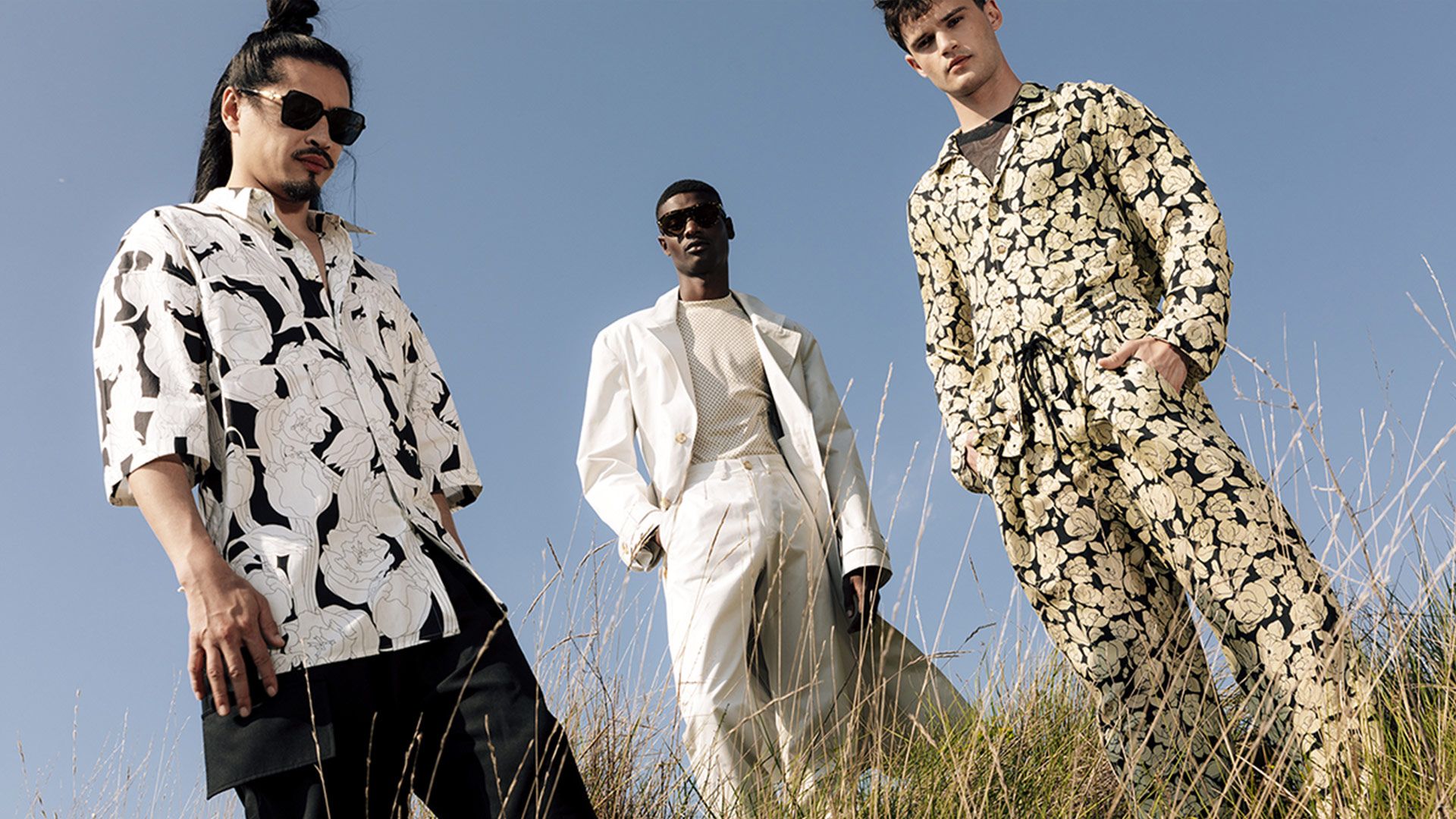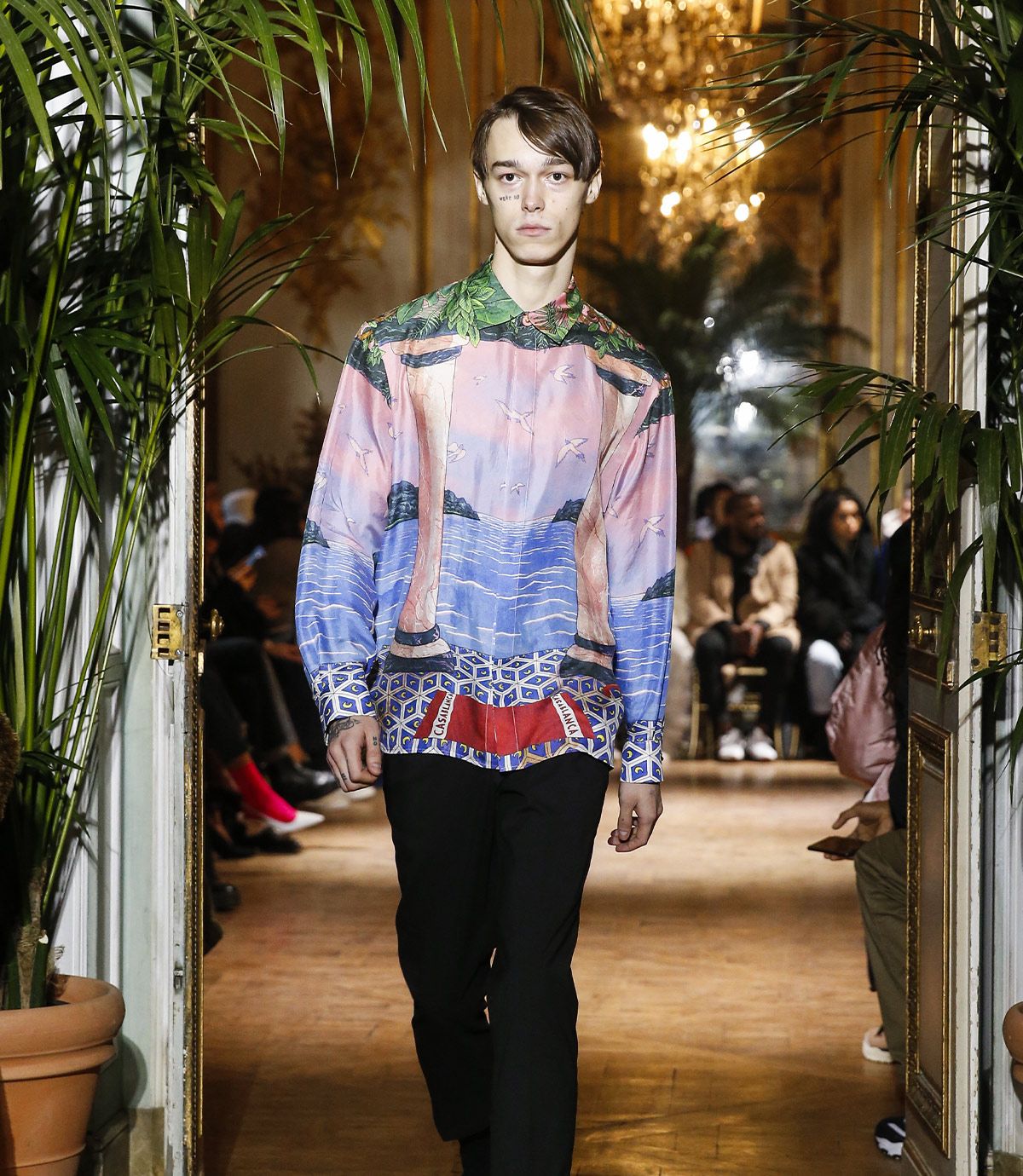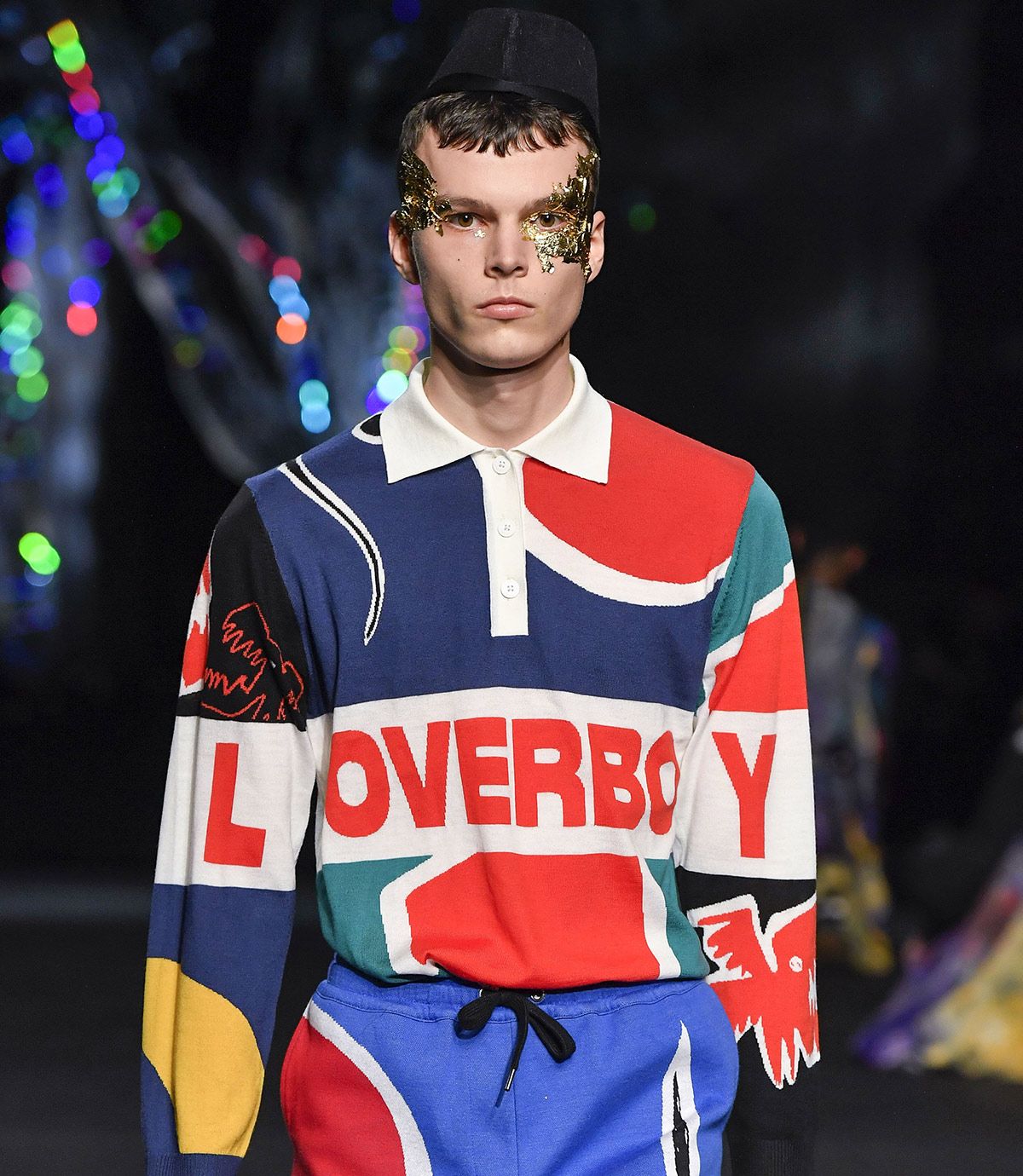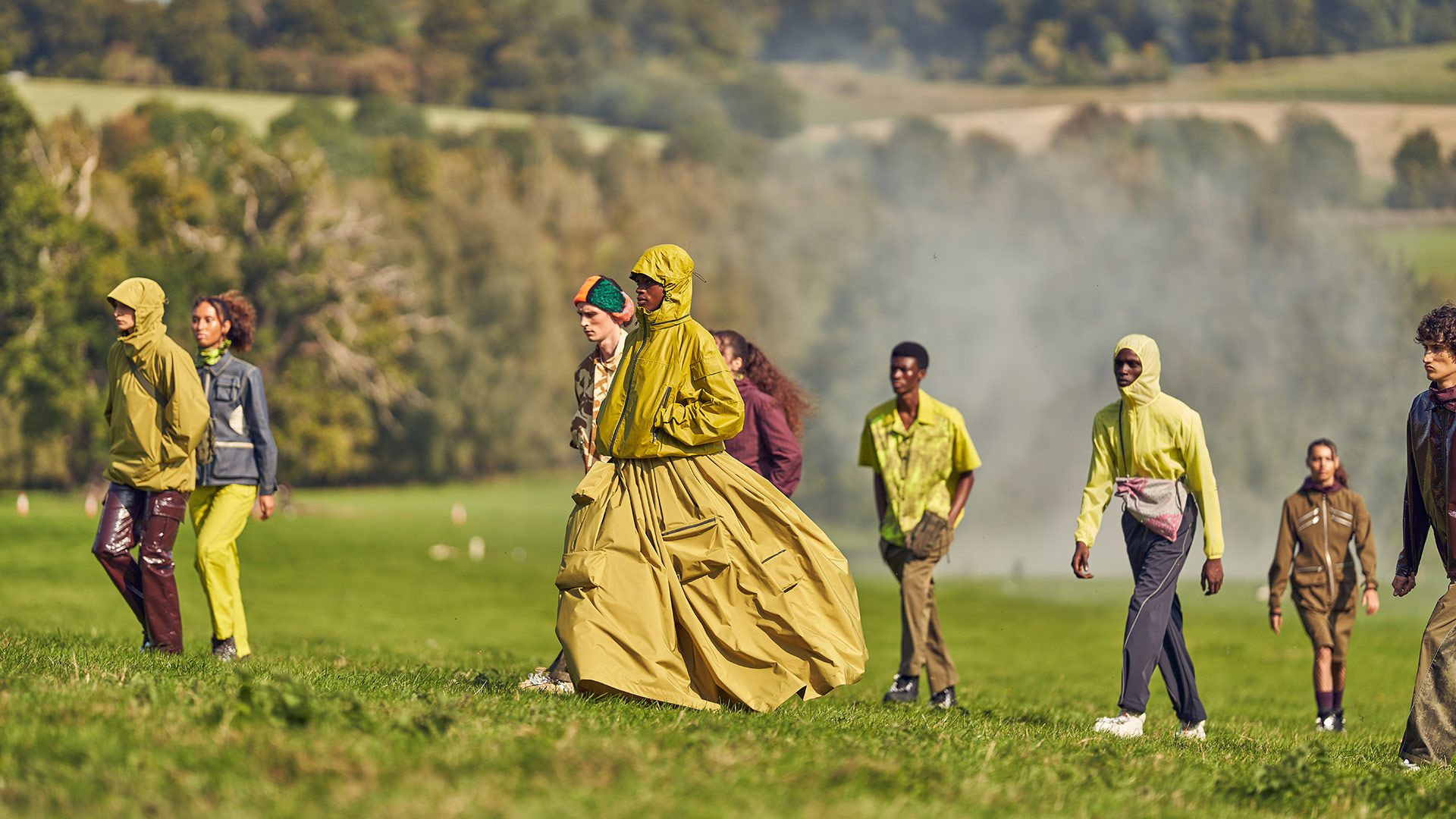Casablanca, Botter, Martin Rose: Men's Fashion Gets an Upgrade

From right to left: Printed Shirt: Gucci, Trench and Trousers: Mansour Martin, Relaxed Shirt and Trousers: Nanushka.
A fresh take on diversity
From Rei Kawakubo's creations for Comme des Garçons in the 1970s to Jean Paul Gualtier's men's skirts the following decade, and the sober eccentricity of 1990s Alexander McQueen, menswear is no stranger to pieces that are as unique as they are transgressive, and a far cry from the three-piece suit of yore. But everything changed at the turn of the millennium: nearly fifty years after the founding of Dior, who in its heyday revolutionized women's fashion with its New Look, Hedi Slimane was named Artistic Director of the label's men's department, where he was determined to dust off the masculine silhouette. Fitted pants, slim shirts, and super-skinny ties set the tone as decidedly rock-n-roll, and the polar opposite of the 1980s' oversized suits and the 90s' baggy casual. In black and white, raw denim and dark leather, the man of the 21st century is to-the-point, with a hint of androgyny, and seems as if he was ready-to-go (and perfectly put-together) in five minutes flat. The public was quick to pick up on the new aesthetic, along with some of the biggest names in the industry: Karl Lagerfeld himself admitted to having shed a few pounds in order to better adopt the newly-ubiquitous look. And yet, in the face of the almost-rebellious trend's widespread adoption, other fashion tropes found themselves relegated to the back-burner. Over the course of several seasons, the party line in menswear has been moving ever-so-slowly, but surely, towards a more diverse, colorful, and explosive style. From Kim Jones at Louis Vuitton to Virgil Abloh — to whom he ceded his place at the trunk-maker to take up residence at Dior — via Daniel Lee at Bottega Veneta, Jonathan Anderson and Dion Lee, or the now-defunct Sies Marjan, masculinity evolved and was adorned with new codes drawn directly from athleisure and women's wear. With luxe fabrics, plays on proportion, extravagant accessories, and surprising color-palettes, today's pieces have got originality in spades. It's a heartening ascent that's as inventive as it is liberating. Here, a rundown on the wunderkinds who are in it to change the game.

Casablanca, the sportiest
Since 2018, Charaf Tajer, founder of the Casablanca label, has been revisiting sportswear and endowing it with retro elegance. Distinct from recent athleisure trends, its aesthetic is anchored in the luxury sporting events of yesteryear. In sumptuous materials, original prints created in Lyon and Côme, saturated colors, and comfortable cuts, men's (and women's) wardrobes are granted a punchy elevation.
Botter, the most committed
Founded by Rushemy Botter and Lisi Herrebrugh in 2017, this menswear brand is a tribute to the two Dutch designers' Caribbean roots — the former hailing from Curaçao, and the latter from the Dominican Republic. A dynamic duo at the studio as they are out on the town, the couple (who's also at the head of Nina Ricci's Artistic Direction) denounces overfishing, the decimation of coral reefs, and the lack of diversity in the industry through its colorful designs. Their scintillating talent has already been lauded at the International Fashion Festival in Hyères, as well as at the prestigious LVMH Prize in 2018.
GmbH, the most experimental
After meeting on the dance floor at a techno club, Serhat Isik and Benjamin Alexander Huseby joined forces to launch GmbH (an acronym for "Gesellschaft mit beschränkter Haftung," similar to "Limited Liability Company") in 2016. While Isik grew up in Germany, Huseby comes from Sweden. Together, they've dreamt up a style that's both experimental and androgynous, bucking convention and mixing innovative and unexpected materials. Such audacity even won them a spot on the shortlist for LVMH's 2017 prize.
Charles Jeffrey Loverboy, the most flamboyant
Inspired by club culture, Charles Jeffrey's brainchild Loverboy is as hypnotic as it is enveloping. Since 2015, the British designer has been inviting the spirit of the dance floor into the everyday wardrobe, for an attitude that's high-octane and irreverent — pieces guaranteed to add a kick to any ensemble.

Telfar, the most democratic
In the interest of appealing to the masses, Telfar has been putting out gender-neutral pieces for nearly a decade now. But it was when the label began to offer its shopping totes in faux-leather — integrating a pre-order scheme that was both novel and imminently democratic, and paragraph fw-bolders that blew away the competition — that the world began to recognize what this brand was bringing to the table; namely, mind-blowing talent with an anti-capitalist wink. Their slogan? "It's not for you, it's for everyone." Count us in!
Martine Rose, the most daring
While men dressing women is common in the fashion industry, the opposite is less true. Spotting the vacancy, English creator Martine Rose and her girl gang have been shaking up masculine style since 2007. Playing on scale, textiles, traditional notions of gender, and investing her creations with a cultural and political consciousness, this Croydon native was honored at the British Fashion Awards in 2017 and 2018 — the same year the brand was also presented at the ANDAM and LVMH Prizes.
Wales Bonner, the most precocious
Graduating from Central Saint Martins in 2014, British designer Grace Wales Bonner established her eponymous label around the same time. Initially interested in menswear, it wasn't until she won the Prize for Emerging Menswear Designer at the 2015 British Fashion Awards that she began to integrate women's designs. In 2016, her talent was recognized by the LVMH Young Designer Prize, and in 2020 she was awarded the BFC/Vogue Designer Fashion Fund. Not-to-be-missed.

Paria Farzaneh, the most surprising
Raised in London, it is to her native Iran that Paria Farzaneh consistently pays homage through her collections. Tending towards the streetwear side of the spectrum, the creator displays a penchant for Persian patterns that lend her collections a striking richness. Here, we travel between cultures to find the key to a personal style that transcends borders and norms.